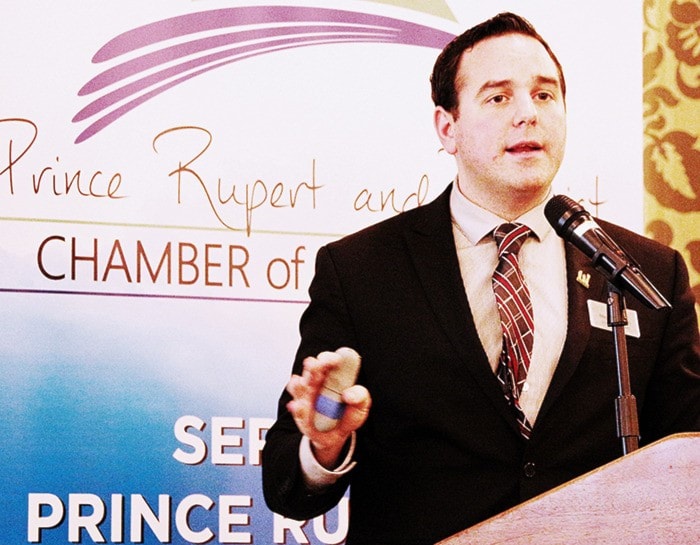Visions and plans are nothing but hot air without implementation.
Prince Rupert mayor Lee Brain’s speech at the first Chamber of Commerce lunch of 2016 promised more than idle words on how the City’s Hays 2.0 vision of Prince Rupert is grounded in reality.
He laid out the five point vision including improvements to infrastructure, public engagement on the redesign of the city, co-existence between industry and building a green community, partnerships with First Nations and becoming a global community.
Brain spoke about how these visions are grounded in reality. But some of the reality is daunting, such as the City’s $260 million infrastructure deficit. The Re:Build Rupert vision attempts to tackle that issue with an asset management program and an infrastructure renewal program.
“At the moment we have major infrastructure problems that are public safety issues and those are our key targets at the moment. They’re not sexy developments, in fact most of you won’t even really see what’s going on but we must address those first,” Brain said.
For example, the Water Works project, to secure the city’s access to its water supply, is in its first phase to build a road to the dam. The Water Works project will cost $13 million, said Brain, but a federal and provincial grant of $4.4 million will fund a chunk of the $6.6 million cost of phase one.
The next point in the vision is Re:Design Rupert, an 18-month public engagement process is planned to avoid the traditional boom and bust of an industrial town.
“We’re going to bring a facilitator in to start the process of saying, ‘Hey, how do we want to look after a major industrial boom’,” Brain said adding that after the boom “the community’s fabric ends up getting decimated in some ways”.
The process of design began this month when urban designer, Mark Lakeman of the Portland City Repair Project, presented his “Placemaking” community designs to over 200 residents at the Lester Centre. Although the initiative is being spearheaded by Transition Prince Rupert the City took part in Lakeman’s weekend workshop and is keen to re-engage neighbourhoods through design, starting with McKay Street Park.
Point three is building the foundations for the 2030 Sustainable City. “Having an integration of two worlds coming together where we are a green community as well as a community where good quality jobs exist,” Brain said.
In the first council meeting of the new year, the mayor and councillors put forward a motion to develop a policy group that will integrate both sustainable green business practices with industry.
The fourth point, First Nations partnerships was thinly detailed compared to the other points. The mayor said that this point is part of Hays 2.0 core underpinnings and the City is engaged in a “variety of fronts to form major partnerships” and once in place it will be announced.
The fifth and final point for Hays 2.0 is the grandest of all the visions: becoming a global community. The city is the fastest growing port in North America and an intercontinental hub through CN rail access. But Brain dreams big and expands his vision into the Northern Passage Trade Gateway.
“It could be somewhat of a controversial subject. Nobody has really put a pin on this concept and I think we’ve hit something here,” he said.
The mayor, who said he is also a Canadian Ranger, spoke to the crowd about the importance of Arctic sovereignty for the Canadian government and the potential for Prince Rupert to become the future Northern Passage gateway for trade along the Northern Sea Route, above Russia, and the Northwest Passage, above Canada.
“What I want people to understand is we’re just putting this out as an argument to say, ‘Is this possible?’ If it’s not, that’s fine. However, the future in the 21st century in the global economy is the Arctic and all the countries and the UN know that and they’re pushing that way,” Brain said.
The speech highlighted more vision than reality but Hays 2.0 is still in its early stages.
Brain’s dream to build a city that co-exists with industry and green community development is unparalleled.
“We’re actually trying to create a model here,” he said. “That’s what we’re trying to showcase to the LNG industry or other industries that you want your workers to say, ‘I don’t want to move, I love working here, I love living here.’”
